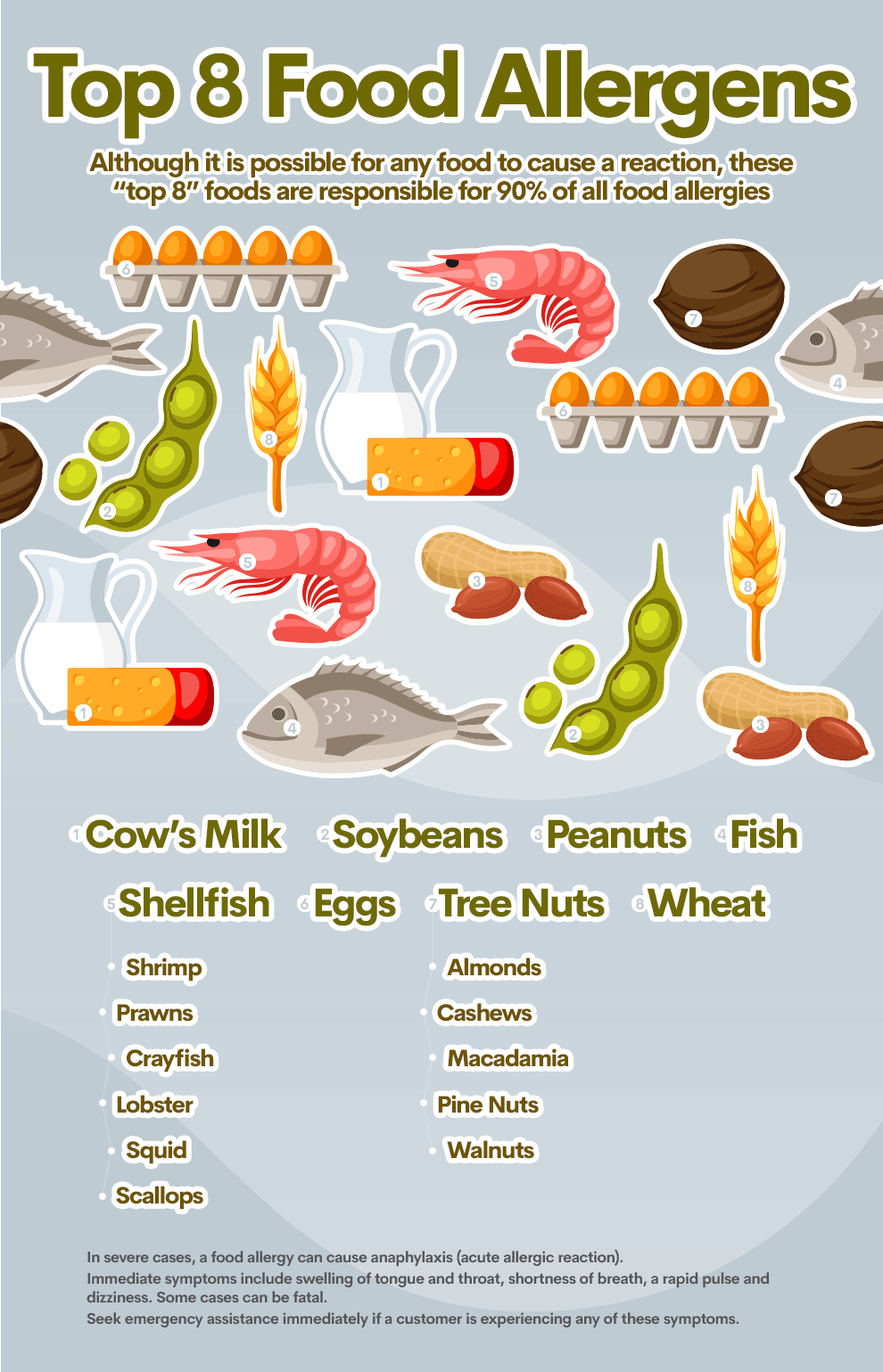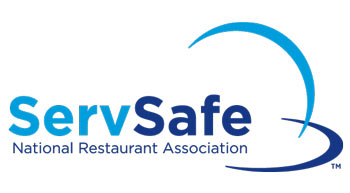Not creating a food-allergen safe kitchen could end up costing you ... big time.
Picture this. You own a popular restaurant and one of your servers, who has never had any food allergen training, was told by a customer they could not have any dairy in their food due to an allergy. Let’s say your server assumed this only meant the guest could not have milk or cheese, so he or she did not double check to see if the sauce on the grilled steak they ordered had butter in it. In good faith the guest devours the deliciously tenderized steak and almost immediately goes into anaphylactic shock and ends up in the hospital. Imagine the litigation your restaurant may have to face as a result of the incident, or worse, the negative impact it could have on your brand.
Remember, it is not the waiter’s fault. According to a recent CDC and US Department of Health and Human Services survey and report, approximately half of the restaurants surveyed did not provide food allergy training for their employees, and what was provided didn’t cover important information such as what to do if a customer has a bad allergic reaction (i.e. difficulty breathing).
So, what should you do? The first step is to understand what allergens are, how they work and don’t work, and appropriately prepare your kitchen and train staff in order to prevent any serious food allergy incidents from occurring at your restaurant.
Not-so-fun facts via the Centers for Disease Control and Prevention (CDC):
- Food allergies affect an estimated 15 million people in the US alone.
- Allergies are responsible for approximately 30,000 emergency room visits and between 150-200 deaths each year.
- Nearly half of reported fatal food allergy reactions were caused by food from a restaurant or other foodservice business.
- 4 out of every 100 children have a food allergy.
What is a food allergy?
A food allergy is a medical condition in which exposure to a food triggers a harmful immune response. The reaction occurs because the immune system attacks the proteins (allergens) in the food that would normally be harmless. The proteins that trigger the reaction are called allergens.

Not creating a food-allergen safe kitchen could end up costing you…big time.
Picture this. You own a popular restaurant and one of your servers, who has never had any food allergen training, was told by a customer they could not have any dairy in their food due to an allergy. Let’s say your server assumed this only meant the guest could not have milk or cheese, so he or she did not double check to see if the sauce on the grilled steak they ordered had butter in it. In good faith the guest devours the deliciously tenderized steak and almost immediately goes into anaphylactic shock and ends up in the hospital. Imagine the litigation your restaurant may have to face as a result of the incident, or worse, the negative impact it could have on your brand.
Remember, it is not the waiter’s fault. According to a recent CDC and US Department of Health and Human Services survey and report, approximately half of the restaurants surveyed did not provide food allergy training for their employees, and what was provided didn’t cover important information such as what to do if a customer has a bad allergic reaction (i.e. difficulty breathing).
So, what should you do? The first step is to understand what allergens are, how they work and don’t work, and appropriately prepare your kitchen and train staff in order to prevent any serious food allergy incidents from occurring at your restaurant.
Not-so-fun facts via the Centers for Disease Control and Prevention (CDC):
- Food allergies affect an estimated 15 million people in the US alone.
- Allergies are responsible for approximately 30,000 emergency room visits and between 150-200 deaths each year.
- Nearly half of reported fatal food allergy reactions were caused by food from a restaurant or other foodservice business.
- 4 out of every 100 children have a food allergy.
Not creating a food-allergen safe kitchen could end up costing you…big time.
Your staff only needs to be trained one time. Think again. Many training and certification programs require training for all new staff and ongoing training for management in order to maintain best practices.
Food intolerances and food allergies are one and the same. They are not. While food intolerance can cause some delayed reactions (up to 72 hours) like bloating, stomach upset and joint pain, these are not deadly and can clear up on their own. Food allergies can trigger life threatening reactions within minutes, and up to 2 hours after food ingestion because it affects the immune system.
Consuming allergens in small amounts is safe. It is not. Even minute quantities can cause a reaction in sensitive individuals.
Heat fryers destroy allergens. Nope. Allergic reactions are caused by proteins in the food. Food particles that stay behind in the fryer oil can cross-contaminate foods.
It is safe to remove an allergen such as shellfish or nuts from a finished meal. Do not just take it off the plate. Trace amounts of these reaction-causing foods can be left behind after contact with other foods.

How to prevent food allergy incidents at your restaurant
Provide ingredient lists for all menu items. These lists are important to help the staff determine which menu items contain common allergens. A restaurant should be able to supply this list upon patrons request.
Create an allergen-safe menu. Providing a restaurant disclaimer for food items that are prepared with foods that contain the "Top 8"allergens, offering substitutions where applicable, and denoting allergy-friendly meals with icons can greatly reduce the risk of allergic reactions among guests and help those with allergens feel more welcome in your establishment.
Take special requests seriously. When a customer says that he or she has a food allergy, it should be noted immediately on the ticket and should be conveyed to the manager of the establishment. Many customers with serious allergies will call ahead to ensure they can be accommodated. Any reservations taken should include a note about the food allergy.
Dedicate equipment and areas specifically for preparing allergen-free food. Proteins from allergens can remain on equipment even after it's wiped clean. Color-coded equipment can be used for quick identification and keeping certain areas dedicated to preparing allergen-free meals can further reduce the risk of allergic reactions among patrons.
Restaurants should also consider designating a fryer for cooking allergen-free foods only, as the oils used to deep fry several different foods may still contain protein from previously fried food items.
Using splash guards for sink areas dedicated to preparing allergen-free foods can help reduce the chance of cross-contamination during food prep.
Having a separate pickup area for finished meals can prevent problems such as delivering the wrong food to patrons, garnishing the wrong dishes or cross-contaminating allergen-free foods with food allergens from unclean hands, trays or food splashes.

Hold regular food allergy trainings for management and staff
Nowadays, it isn’t enough to say your staff has been trained once. Because of the rise in allergic reactions resulting in legal action taken against establishments, many online certification programs recommend training for all new staff and additional, annual training to maintain best practices.
Trainings should cover the major food allergens, symptoms of allergic reactions, how to prevent cross-contact and what to do if when a customer has a bad allergic reaction.
The Food and Drug Administration Food Code recommends that management be knowledgeable about food allergens and ensure that employees are properly trained in food allergy and safety awareness.
The top online training programs include ServSafe, which offers extensive management training and Food Allergy Research & Education (FARE), which offers food allergy training for restaurant workers, schools and childcare facilities.
How do I know if someone is having a serious reaction?
When a person eats a food he or she is allergic to, the reaction may travel through the body rapidly.
Look out for the following symptoms that indicate a potentially serious allergic reaction:
- Swelling of the lips, tongue and throat
- Difficulty breathing
- Hives
- Abdominal cramps
- Vomiting
- Diarrhea
- Indications that a person is going into anaphylactic shock (severe allergic reaction) include dizziness and/or fainting and the feeling something awful is about to happen (anxiety) - in addition to one or more of the above symptoms.
What do I do if a customer is experiencing anaphylaxis (severe allergic reaction)?
- Call 911.
- See if they have an epinephrine (adrenaline) auto-injector or EpiPen and help them, if needed.
- Try to keep the person calm until emergency help arrives.
- Help the person lie on their back, and if possible, raise their feet above their head 12 inches.
- Make sure their clothing items are loose so they can breathe.
- Avoid giving oral medications, anything to drink, or lifting their head, especially if they’re having trouble breathing.
- In cases where the person isn't breathing or moving, CPR may need to be performed.
While these reactions sound scary (and they definitely can be), setting up your kitchen with the proper equipment and staff with the knowledge on how to deal with food allergens, you will be making long strides toward avoiding problematic situations and even welcoming a larger population of guests to your establishment.
Need help equipping your kitchen for food allergen safety? Talk to our kitchen buildout specialist, Mike Ellin, 404-752-6715 (ext.130) to learn more about what you need to create a food-allergen safe space!
Enjoyed this article? Click here to stay up-to-date on industry news and receive exclusive sales and promotions.


